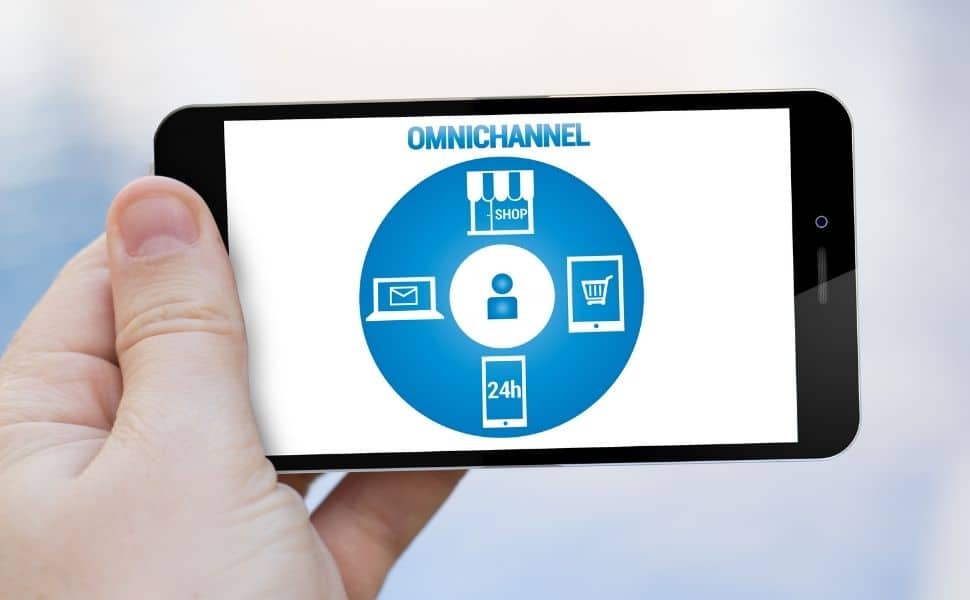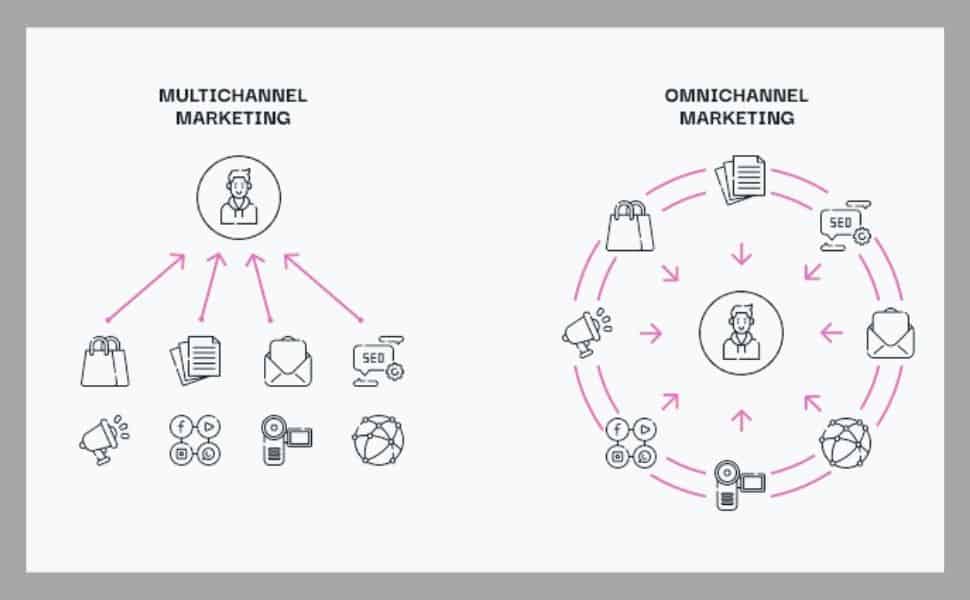Make no mistake about it – Amazon is a terrific distribution channel.
After all, it is the #1 online marketplace on the planet.
However, you can’t cement your brand’s presence on Amazon by depending on a single distribution channel.
In order to stay ahead of the curve, you need a solid omnichannel marketing strategy.
In this post, we take a closer look at omnichannel marketing for Amazon sellers, and why you should adopt this approach to achieve success.
First things first, though.
What Is an Omnichannel Approach?
An omnichannel strategy occurs when a brand adopts a holistic approach to address every customer touchpoint across various channels.
An omnichannel approach allows a business to give its customers a consistent, unified experience on digital and brick-and-mortar touchpoints.

When a business approaches every channel as part of a single brand experience, it ensures that all pieces work in unison, reaching audiences at every customer journey stage.
Furthermore, an omnichannel strategy covers the entire customer journey from brand discovery at the start of the marketing funnel to purchase, advocacy, and beyond.
A well-thought-out omnichannel approach ensures that the customer journey is smooth and frictionless since audiences have the same experience with your brand across all channels.
Why Is an Omnichannel Approach Important?
Sure, implementing an omnichannel approach for your Amazon products isn’t the easiest of tasks. However, when done properly, it offers a host of benefits.
Remember, today’s shoppers are used to being bombarded with numerous brands, and as a result, they’ve become increasingly selective about the products they want to buy.
Therefore, adopting an omnichannel approach can help set your brand apart, bringing these benefits we’ve listed below.
A Better User Experience
The omnichannel approach, at its core, focuses on devices instead of channels. It also helps improve the customer experience. Additionally, by focusing on the customer instead of the platform, you can generate more sales and better retention rates.
Unified Brand Strategy and Identity
Developing a cohesive strategy across your channels translates to creating an easily identifiable brand image and tone. You should build this image based on your customer’s needs and values.
When you focus on your audience’s overall experience and stay within your brand’s guidelines to target each channel, you can develop a seamless brand strategy that will bring in more loyalty and targeted messaging.
Increased Revenue
An omnichannel approach drives your audience to engage with your business across multiple touchpoints and channels.
The augmented varying engagements at every customer journey stage can help boost revenue. In fact, customers that engage with multiple touchpoints are 30% more likely to convert.
Moreover, the targeted messaging helps nurture loyalty, which increases the likelihood of a customer buying from your brand in the future.

Why is this crucial? Well, because repeat customers contribute to 40% of revenue, even though they only make a small percentage of your customer base.
Better Attribution Data
A robust omnichannel strategy should do more than improve a customer’s experience with your brand. It should extend to your data analytics too.
By enabling you to track engagements across channels, your brand can piece together the customer journey. That way, you can know where your audience prefers to engage and which of your campaigns are the most valuable.
The beauty of it is that you can put this information back into your strategy, allowing you to create a more targeted campaign while making the most of your marketing budget.
What Are the Differences Between Omnichannel and Multi-Channel?
Omnichannel and multichannel sound similar.
Still, the two are significantly different, and it is crucial to understand the difference. That way, you can be sure that you’re implementing the right strategies for your Amazon products.
Multichannel is a broader term that refers to any strategy involving more than one channel. Omnichannel, on the other hand, takes it a notch higher by including or accounting for every single channel.
That said, let’s look at the key differences between the two.

Complexity
First of all, omnichannel experiences are somewhat complex to match the complex nature of today’s customer journeys. Multichannel strategies, on the other hand, are pretty straightforward. They seek to create direct lines between channels.
Function
On top of that, a multichannel approach seeks to engage customers while an omnichannel approach focuses on improving customer experience.
With a multichannel strategy, the idea is to cast the net as wide as possible to ensure that more and more customers are aware of your business.
Omnichannel aims to build a consistent customer experience for an audience already aware of and engaging with your brand.
Quality of Support
Another notable difference between omnichannel versus multichannel is the number of channels used as opposed to the quality of support given through the channels.
Multichannel focuses on expanding the number of available channels. However, there’s no real effort to connect these channels, which means that the customer has to start from scratch when switching from one channel to another.
Omnichannel is all about the quality of support offered via your brand’s channels. In essence, this means that customers get the same level of high-quality support irrespective of which channel they’re on and the customer journey stage.
Focus
The last difference between the two is that multichannel focuses on channels while omnichannel deals with customers.
A multichannel marketing strategy aims to optimize the number of channels used to promote your brand. The idea is that with more channels, potential customers can choose how they want to engage with your business. Of course, the more the channels, the more choice your customer has.
The customer – not the channel – is the primary focal point with an omnichannel approach. The goal is to provide a seamless experience as they move from one channel to another, eliminating the friction between the various touchpoints.
In practice, a multichannel strategy would focus on things like digital marketing, SEO, website, billboards, paid channels, emails, social media, and radio adverts.
Inversely an omnichannel approach would focus on social media, websites, and emails, then sync the rest to provide a seamless approach as a customer moves from one channel to the other.
How to Build an Omnichannel Marketing Campaign
Developing an effective omnichannel approach for your Amazon products requires a solid foundation and an integrated strategy.
All your channels must work together in tandem to enable you to test drive the best experience for your customers.
Here are some tips to get started with building your omnichannel strategy.
Research and Gather Insights
As mentioned, an omnichannel approach focuses on your customers. Still, before you can create a customer-centric marketing approach, you have to understand your customer’s needs.
Start by collecting insights on your current customer experience. That way, you can have a firsthand experience of how it feels to walk through your brand.
In order to do so, you’ll want to scroll through your website, buy a product, engage with a chatbot and try to put yourself in your customer’s shoes. Is the experience smooth and seamless? Did you encounter any hiccups? Did you have to go through any unnecessary steps?
Next, reach out to your customers through voice-of-customer (VOC) surveys, customer groups, or reviews. Be sure to listen to their reactions about the shopping experience to enable you to know what’s working and what’s not from a customer’s point of view.
Collecting this feedback will let you know what you need to do to provide a seamless experience.
Lastly, gather insights from teams that deal with various aspects of your brand. Be sure to talk to someone in every channel’s team. Feedback from your team will come in handy when building an omnichannel that works for your customers.
Analyze the Insights
The information you’ve gathered in the first step is only helpful if you take time to analyze and digest it. That way, you can turn the data into actionable insights. As you scrutinize the research, the key point to remember is that your customers should be the focal point.
So, make sure that you’re doing everything with your customers in mind to enable you to create an authentic experience for your audience.
Also, it would help if you didn’t make any assumptions. You see, it is pretty easy to draw conclusions based on your own experience as a shopper. Keep in mind that you’re not the targeted customer or a representative of the entire shopping community.
The point is, make sure that you’re looking at the new research with a fresh perspective to enable you to digest the ramifications of each insight.
Focusing on your customer’s needs, by extension, will help you anticipate their needs and, most importantly, allow you to create a well-thought-out omnichannel strategy.
Segment and Customize
At this point, you understand your customer. You’ll now want to create the customer journey.

An omnichannel approach allows you to develop customized messages to suit a variety of customers. That’s why a crucial component of this particular step is to map your customer’s journey.
Once you know how customers interact with your brands, it becomes easy to control these interactions and insert your messaging in the right places at the most appropriate time.
Leverage More Tactical Logistics
Even though viewing your omnichannel approach from a bird’s eye view helps you maintain consistency and cohesive brand identity, it is also important to remember your strategy’s minor yet relevant elements.
For instance, your sales team should speak in the same brand tone as the chatbots on your website.
On top of that, you need to ask yourself critical questions such as: am I offering customer support on my website. How easy is it for a customer to pay once they reach the last step of their journey?
Answering these questions will help you prepare for the last step of this journey.
Test, Measure, Optimize
The last step to building an omnichannel approach is learning and optimizing.
Like any other marketing strategy, omnichannel is in constant motion. Tactics that worked a few months ago may not necessarily give you the same results today.
When you’re up to date with what’s working, you can optimize your messaging and marketing spend to foster a long-term customer relationship while maximizing your return on investment.
Strengthen Connections With an Omnichannel Approach
Customers and prospects engage with your brand across multiple channels daily. You can strengthen these connections via an omnichannel approach.
Leveraging an omnichannel marketing strategy is a crucial element of your overall business as it allows you to define the long term growth of your brand.
Now that you know what an omnichannel approach is all about, it is time to swing into action. And if you need to help get into the swing of things, Signalytics is here to help you work through it.

